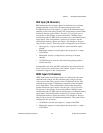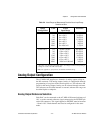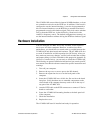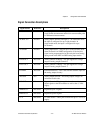
Chapter 2 Configuration and Installation
AT-MIO-16X User Manual 2-12
©
National Instruments Corporation
Analog Output Polarity Selection
Each analog output channel can be configured for either unipolar or
bipolar output. A unipolar configuration has a range of 0 to V
ref
at the
analog output. A bipolar configuration has a range of –V
ref
to +V
ref
at
the analog output. V
ref
is the voltage reference used by the DACs in the
analog output circuitry and can be either the 10-V onboard reference or
an externally supplied reference between –18 and +18 V. Both channels
need not be configured for the same range.
Selecting a bipolar range for a particular DAC means that any data
written to that DAC will be interpreted as two’s complement format.
In two’s complement mode, data values written to the analog output
channel range from –32,768 to +32,767 decimal (8000 to 7FFF hex). If
unipolar range is selected, data is interpreted in straight binary format.
In straight binary mode, data values written to the analog output channel
range from 0 to 65,535 decimal (0 to FFFF hex).
Digital I/O Configuration
The AT-MIO-16X contains eight lines of digital I/O for
general-purpose use. The eight digital I/O lines supplied are configured
as two 4-bit ports. Each port can be individually configured through
programming of a register in the board register set as either input or
output. At system startup and reset, the digital I/O ports are both
configured for input.
Board and RTSI Clock Configuration
When multiple AT Series boards are connected via the RTSI bus,
you may want all of the boards to use the same 10-MHz clock. This
arrangement is useful for applications that require counter/timer
synchronization between boards. Each AT Series board with a RTSI bus
interface has an onboard 10-MHz oscillator. Thus, one board can drive
the RTSI bus clock signal, and the other boards can receive this signal
or disconnect from it.
Many functions performed by the AT-MIO-16X board require a
frequency timebase to generate the necessary timing signals for
controlling ADC conversions, DAC updates, or general-purpose signals
at the I/O connector. You select this timebase through programming one
of the registers in the AT-MIO-16X register set.


















